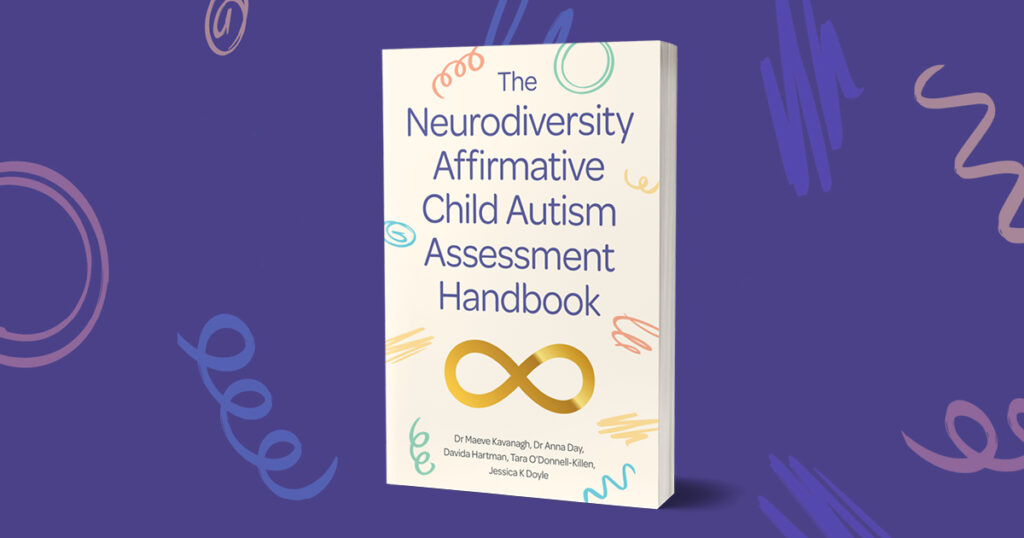
This is an extract from The Neurodiversity Affirmative Child Autism Assessment Handbook – The first handbook on neuro-affirmative child autism assessment, written by a group of qualified psychologists and Autistic experience advocates, who are neurodivergent themselves.
We all get told stories – as children, the bedtime story is a precious point of
connection for both adult and child, enjoying closeness, sharing of imagination,
providing a space for discussing ideas. As we grow older, we learn to read,
and access more stories ourselves. We soon learn that stories exist not just in
books, but in the narratives that society tells us about ourselves, others, the
‘right’ way to look, act and behave. These narratives are typically dominated
by what is perceived to be ‘normal behaviour’ at that particular time, and
frame how we see ourselves and our position in the world. There has been a
much-needed shift in children’s fiction written by neurodivergent authors, such
as Elle McNicholl, featuring main characters who are Autistic or otherwise
neurodivergent. These stories present a re-framing of Autistic experience,
providing both an intensely enjoyable reading experience but also a springboard
for discussion of how others treat people perceived as ‘different’ (e.g., Addie in
A Kind of Spark (McNicholl, 2020) makes it her mission to achieve a memorial to
the women killed in the Scottish Witch Trials merely for being different). Wider
society and clinicians have much learning to do from thinking about the stories
we tell our children, be that in fiction or the dominant narratives that prevail
about how to be in the world.
Many young people come to us with a veritable library of negative stories
that they have been told (either implicitly or explicitly) about their ways of
being (‘you’re weird’, ‘you never listen’, ‘you can’t do X’, ‘you need to be Y’),
only to leave the assessment space being given yet another negatively framed
story: they are someone who has autism, and the story told about what
autism ‘is’ is often deficit-laden. Put simply, this can feel akin to being told
we have something like head lice – the having implies a condition, disorder or
something unpleasant that needs removing (head lice need removing, with
careful scrutiny, combing, chemical shampoos…). This is the type of narrative
that leads to ‘intervention’ based on neuro-normative goals and neurotypical
developmental trajectories. This is the approach we seek to challenge in this
book. Unlike head lice, autism does not require treatment or combing out
– being Autistic runs through our neurology in the same way that words or
streaks of colour run through sticks of sweet seaside rock (long coloured candy
sticks typically with the name of the place ‘written’ inside). Any effort to pull
the writing out of the rock is not going to end well for anyone concerned.
Neuro-normative refers to social, cultural and personal norms which
assumed neurotypicality as the ‘norm’ in how to think, feel, behave and
communicate (Herrán Salcedo, 2021).
For many Autistic children, young people and adults, the dominant, deficit laden
rhetoric surrounding ‘diagnosis’ and deficit means that when they are
identified as Autistic, they may be presented with stigmatised and negatively
valanced accounts of what being Autistic is. Such damaging frameworks can
create false perceptions of that person in both how they see themselves and
how others perceive them (Hobson, 2011). The path to formal discovery of
identification is typically based on struggling and distress. Our ways of being
are seen as problematic and pathological, and we carry the burden of that.
Deficit-based identification processes mean these narratives can be internalised
and impact well-being (Farahar, 2023).
Assessed within a deficit-based frame, an ‘autism diagnosis’ can become
a negative part of the child’s story, both in the story that they create for
themselves and how those around them re-story the young person as
‘disordered’. As Bernadi (2023) observes, an autism ‘diagnosis’, and the negative
narratives surrounding this, in effect creates a new and ‘forged’ identity.
When it is delivered through a medical-based, deficit-laden approach, autism
‘diagnosis’ can be situated akin to chronic illness, instigating a drive for
‘correctional’ therapies (Bernadi, 2023). Parents/caregivers and those around
the young person must navigate, and try to reconcile, the different narratives
that they see surrounding each young person around Autistic experience; one
that is deficit-laden against another that celebrates and welcomes Autistic
ways of being and does not see this as problematic. For example, from her
study involving teaching assistants, teachers, special educational needs
coordinators, deputy head teachers, ten Autistic children, ten parents, and ten
Autistic adults, Wood (2019b) reported that there was a disconnect between
the deficit-based descriptions of autism that participants felt unable to
question and the actual child they knew.
Another telling of this story is that we are Autistic, being Autistic is part of
our fundamental neurology and is part of the beautiful and vital diversity of
life. As we will explore in Chapter 5, this is the story told by the Neurodiversity
Paradigm which underpins how we approach collaborative discovery of Autistic
identity with the young people with whom we have the privilege of working.
Our collective shift to neurodiversity affirmative practice has reflected a
move from a pathologising epistemological approach to an empowering one.
(Jackson-Perry et al., 2020, p. 133).